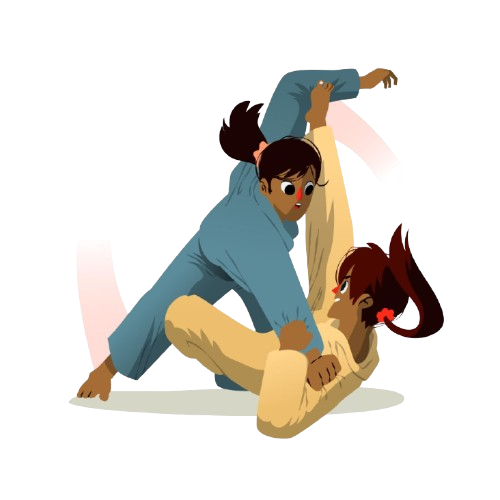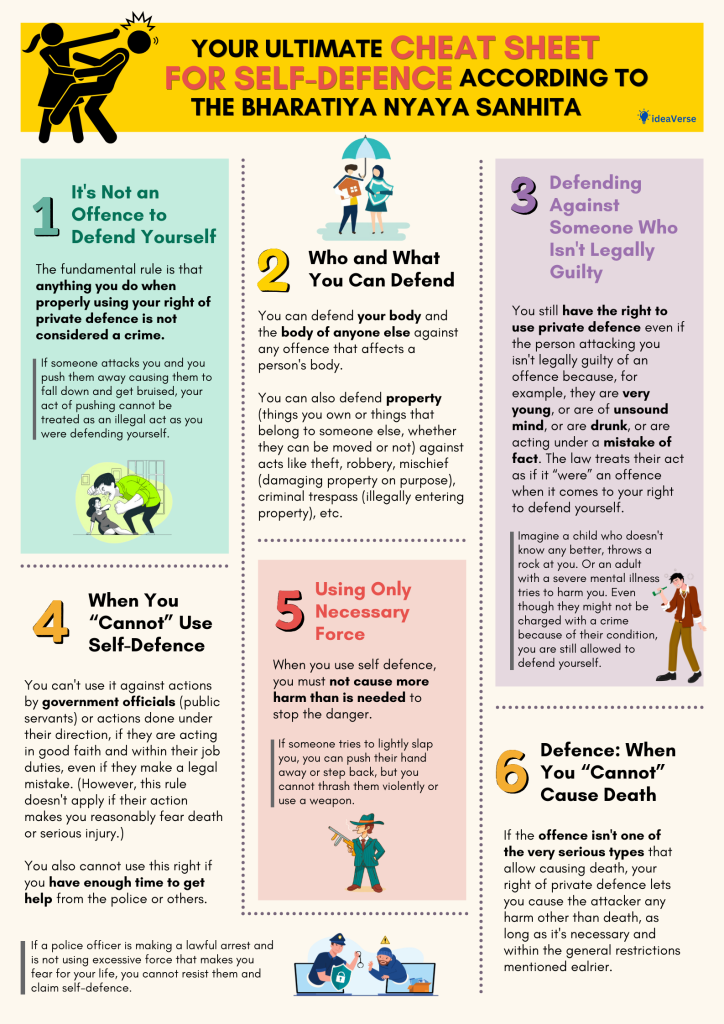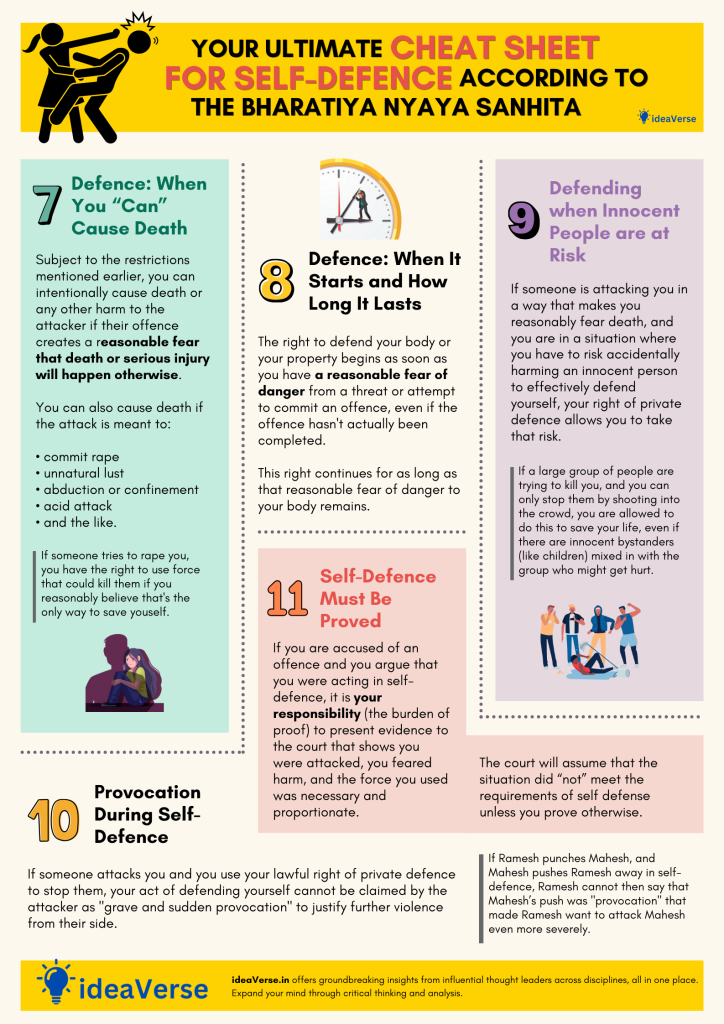- The fundamental rule is that anything you do when properly using your right of private defence is not considered a crime.
- If someone attacks you and you push them away just to stop the attack, the act of pushing is okay because you were defending yourself, so it's not treated as an illegal act.
- However, many think “He hit me, so I’ll teach him a lesson.” That’s not self-defence — that’s revenge and it can make you the accused.

Table of Contents
It’s Not an Offence to Defend Yourself
The fundamental rule is that anything you do when properly using your right of private defence is not considered a crime.
If someone attacks you and you push them away just to stop the attack, the act of pushing is okay because you were defending yourself, so it’s not treated as an illegal act.
Who and What You Can Defend
You can defend your body and the body of anyone else against any offence that affects a person’s body. You can also defend property (things you own or things that belong to someone else, whether they can be moved or not) against acts like theft, robbery, mischief (damaging property on purpose), criminal trespass (illegally entering property), etc. This right is limited by general restrictions mentioned later.
You can protect yourself if someone tries to hit you. You can also protect your friend if someone tries to attack them. And, if someone tries to steal your car or spray paint your wall, you can defend your property to stop them.
Defending Against Someone Who Isn’t Legally Guilty
You still have the right to use private defence even if the person attacking you isn’t legally guilty of an offence because, for example, they are very young, or are of unsound mind, or are drunk, or are acting under a mistake of fact. The law treats their act as if it “were” an offence when it comes to your right to defend yourself.
Imagine a child who doesn’t know any better, throws a rock at you. Or an adult with a severe mental illness tries to harm you. Even though they might not be charged with a crime because of their condition, you are still allowed to defend yourself.
When You “Cannot” Use Self-Defence: General Restrictions
- You can’t use it against actions by government officials (public servants) or actions done under their direction, if they are acting in good faith and within their job duties, even if they make a legal mistake. However, this rule doesn’t apply if their action makes you reasonably fear death or serious injury.
- You also cannot use this right if you have enough time to get help from the police or others.
If a police officer is making a lawful arrest and is not using excessive force that makes you fear for your life, you cannot resist them and claim self-defence. If someone is merely shouting threats from a distance, and you can safely call the police for protection, you must do that instead of physically confronting them and claiming self-defence.
Knowing vs. Not Knowing Someone is a Public Servant
The restriction about not defending yourself against a public servant doesn’t apply if you don’t know, or don’t have a good reason to believe, that the person is a public servant.
If someone in plain clothes tries to force you to do something, and they don’t tell you they are a police officer or show any badge, you can defend yourself against them if their action is unlawful.
Using Only Necessary Force
When you use private defence, you must not cause more harm than is needed to stop the danger. If someone tries to lightly slap you, you can push their hand away or step back, but you cannot punch them violently or use a weapon.
Body Defence
When You CAN Cause Death
Subject to the restrictions above, you can intentionally cause death or any other harm to the attacker if their offence creates a reasonable fear that death or serious injury will happen otherwise. You can also cause death if the attack is meant to commit rape, unnatural lust, abduction, or wrongfully confining you in a way that makes you fear you won’t be able to reach public authorities for help. Causing death is also allowed if the attack involves throwing or attempting to throw/administer acid that reasonably causes fear of serious injury.
If someone tries to rape you, you have the right to use force that could kill them if you reasonably believe that’s the only way to save youself.
When You CAN Cause Harm, But NOT Death
If the offence isn’t one of the very serious types listed above that allow causing death, your right of private defence lets you cause the attacker any harm other than death, as long as it’s necessary and within the general restrictions.
If someone tries to lightly shove you, you can stop them by pushing them away without causing them serious injury, but you cannot kill them.
When It Starts and How Long It Lasts
The right to defend your body begins as soon as you have a reasonable fear of danger from a threat or attempt to commit an offence, even if the offence hasn’t actually been completed. This right continues for as long as that reasonable fear of danger to your body remains.
If someone raises a weapon and threatens you, your right to defend yourself starts immediately because you have a reasonable fear of harm. It stops when they drop the weapon and back away.
Property Defence
When You CAN Cause Death
Subject to the restrictions, you can intentionally cause death or any other harm to the person committing the wrong if their offence is robbery, breaking into a house between sunset and sunrise, damaging a building, tent, or boat used as a home or for storing property with fire or explosives, or if it’s theft, mischief, or illegal entry (house-trespass) under conditions that make you reasonably fear death or serious injury if you don’t use this right.
If a robber threatens your life while trying to steal your valuables, you can use force that might kill them to defend yourself and your property.
When You CAN Cause Harm, But NOT Death
If the offence against your property is theft, mischief, or criminal trespass, but it’s “not” one of the serious types listed above, your right of private defence does not allow you to cause death. However, it does allow you to cause the wrong-doer any harm “other than death”, as long as it’s necessary and within the general restrictions.
If someone is simply walking across your lawn (criminal trespass) or trying to steal a plant from your garden without threatening anyone, you can ask them to leave or stop them using reasonable force.
When It Starts and How Long It Lasts
The right to defend property starts when you first have a reasonable fear of danger to the property.
- Against theft: It continues until the thief has successfully run away with the property, or until the police arrive to help, or until you get the property back.
- Against robbery: It continues as long as the robber is causing or attempting to cause death, injury, or illegal restraint to anyone, or as long as the fear of immediate death, injury, or illegal personal restraint lasts.
- Against criminal trespass or mischief: It continues for as long as the person keeps illegally entering or damaging the property.
- Against night house-breaking: It continues for as long as the illegal entry that started with the house-breaking is still happening.
If someone tries to snatch your bag, your right to defend your bag starts right then. If they grab it and run, your right against the thief for theft might continue until they get away with it, or you recover it, or the police help.
Defending Against Deadly Attack Even if Innocent People are at Risk
If someone is attacking you in a way that makes you reasonably fear death, and you are in a situation where you have to risk accidentally harming an innocent person to effectively defend yourself, your right of private defence allows you to take that risk.
If a large group of people are trying to kill you, and you can only stop them by shooting into the crowd, you are allowed to do this to save your life, even if there are innocent bystanders (like children) mixed in with the group who might get hurt.
Provocation During Self-Defence
If someone attacks you and you use your lawful right of private defence to stop them, your act of defending yourself cannot be claimed by the attacker as “grave and sudden provocation” to justify further violence from their side.
If Ramesh punches Mahesh, and Mahesh pushes Ramesh away in self-defence, Ramesh cannot then say that Mahesh’s push was “provocation” that made Ramesh want to attack Mahesh even more severely.
The Person Claiming Self-Defence Must Prove It
If you are accused of an offence and you argue that you were acting in self-defence, it is your responsibility (the burden of proof) to present evidence to the court that shows you were attacked, you feared harm, and the force you used was necessary and proportionate. The court will assume that the situation did “not” meet the requirements of self defense unless you prove otherwise.
The 5 Golden Rules of Real-Life Self-Defence
- There Must Be an Actual or Imminent Threat
- You Must Reasonably Apprehend Danger to Body or Property
- No Time or Resources to Seek State Protection
- Use Only the Necessary & Proportional Force
- Severity of Your Response Depends on Severity of the Threat
Self-Defence in Real Life
You’re driving peacefully on a highway when suddenly, a goods carrier in front of you slams the brakes without any prior signal. Despite your attempt to control the vehicle, your car crashes into the rear of the carrier. Within seconds, a furious man jumps out of the truck, charges at you aggressively, and physically assaults you — punching, grabbing, or even trying to drag you out of your vehicle.
- The man charging at you and using criminal force constitutes an offence.
- You fear that this man may cause significant damage to you or your car.
- There is nobody on the road to stop him, or you do not have enough time to seek help from others.
- He tries to punch you but you block him and forcefully push him away. This results in him falling down on the road.
- As there is no physical harm caused to you, you sit back in the car and drive away.
Self-Defence: Where Most People Go Wrong
Mistake 1: Excessive Retaliation
Many think “He hit me, so I’ll teach him a lesson.” That’s not self-defence — that’s revenge and it can make you the accused.
Mistake 2: Recording Instead of Acting
In today’s social media age, many prioritize filming the attack over defending themselves. The law protects action, not just documentation.
Mistake 3: Not Reporting Afterwards
Even if you acted in genuine self-defence, always report the incident to the police. Your FIR will help prove your intent if legal proceedings arise.
Please note that the statutory laws are subject to periodic amendment.
Please refer original sources for latest updates.
References
Action Items
- Keep a dashcam in your vehicle. It can serve as evidence for both road accidents and physical confrontations.
- Consider carrying a legal self-defence tool like pepper spray (yes, even men can carry it).
- Learn a basic martial art or street survival technique — not to fight, but to create space and escape when needed.
- Avoid the next road rage. Sometimes, walking away is the braver choice — especially if you can de-escalate.






